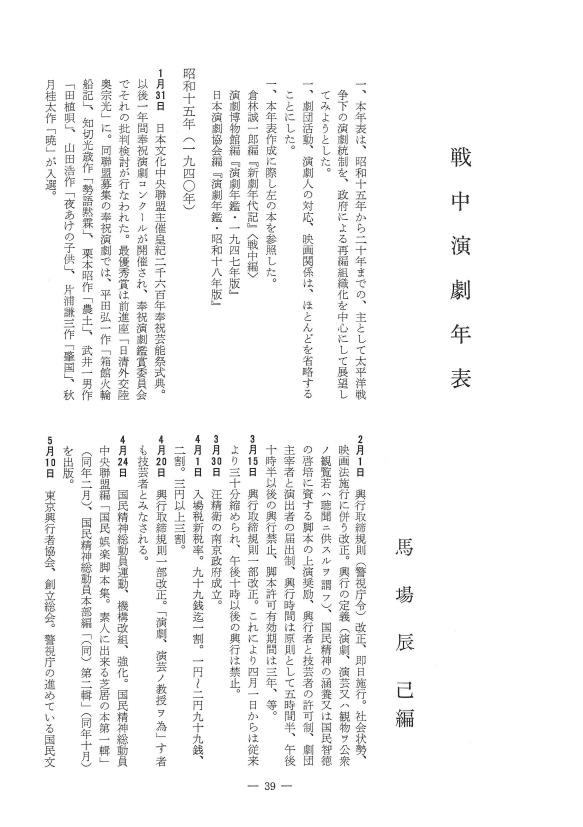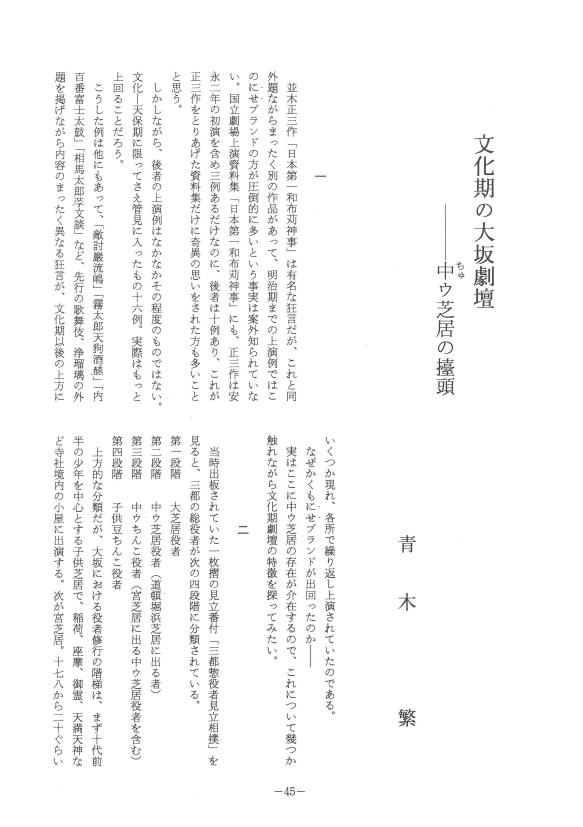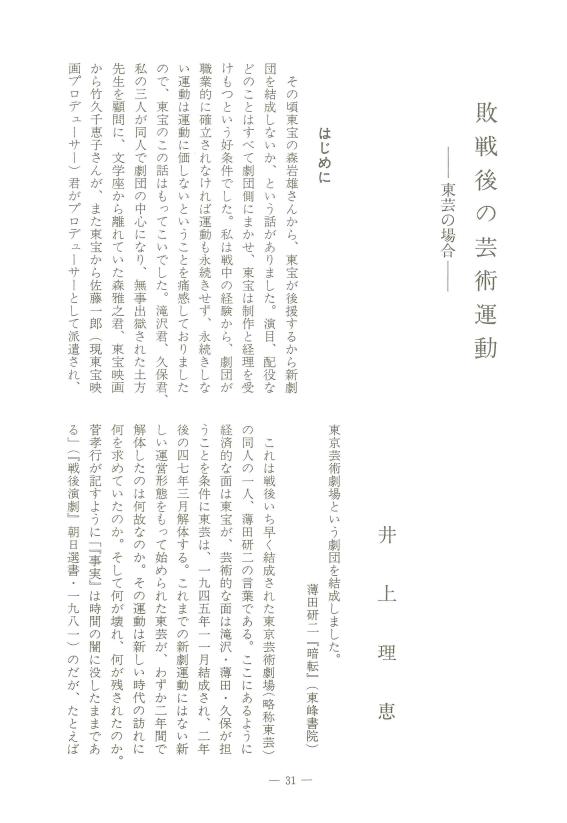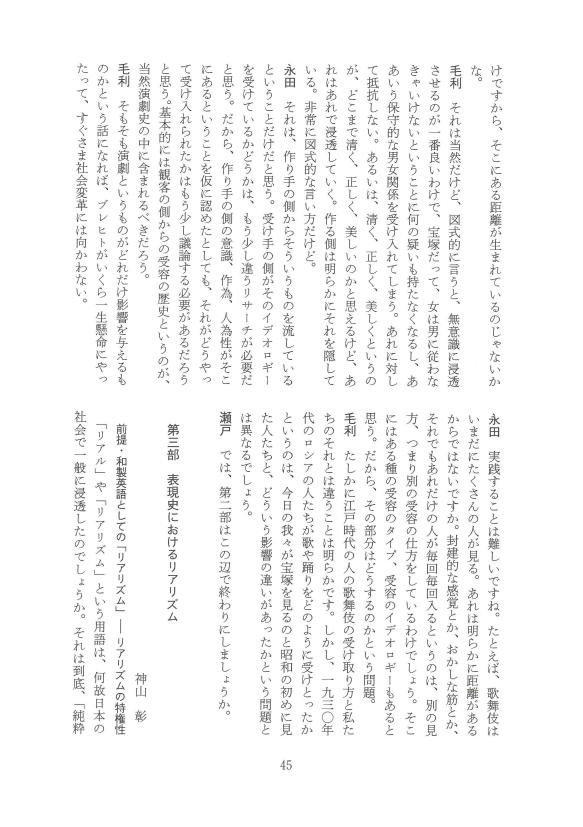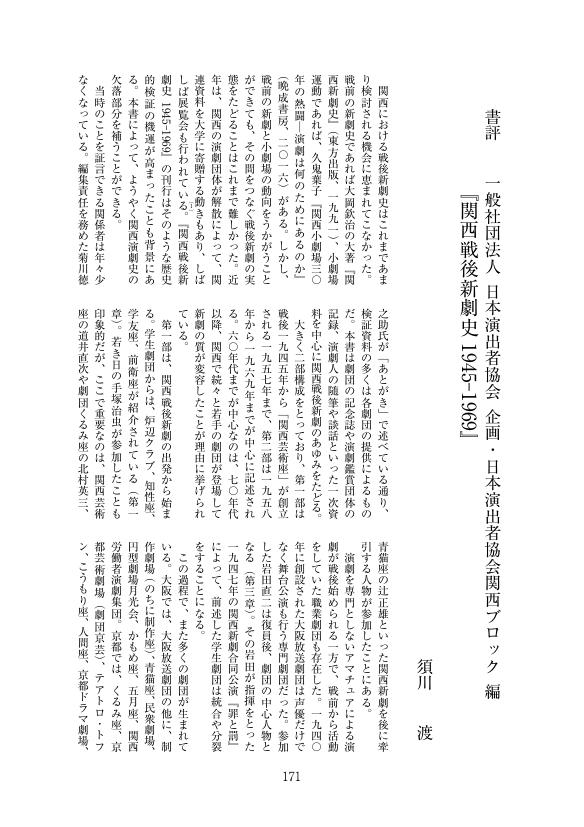1 0 0 0 OA 演劇研究とは何か…… ―日本演劇研究者から
- 著者
- 井上 理恵
- 出版者
- 日本演劇学会
- 雑誌
- 演劇学論集 日本演劇学会紀要 (ISSN:13482815)
- 巻号頁・発行日
- vol.50, pp.139-142, 2010 (Released:2018-01-12)
This paper questions an inclination, in recent years, towards scientific rather than literary papers in the field of Modern Japanese Theatre (MJT). This may be attributable to the nature of the research: in scientific research the outcome is most important and the process is the path to reach it. In addition, more grants are given for and more money is spent on scientific research. Therefore more scientific papers are presented.I have questioned whether or not research on MJT is valuable. The purpose of research in this field is not to discover something completely unknown, but to re-examine MJT history with a fresh viewpoint. This paper adopts a positive perspective on the value of research in MJT. It is regrettable that neither the art nor the richness of writing is to be found in many of the recent research papers about MJT: many are factual and plain like those in the sciences.Works on MJT by scholars from other fields are also discussed critically. Non-specialists of MJT seem to jump at common knowledge and approach the subject by using the research methods of their own fields. This may be because MJT has comparatively smaller research resources and fewer well-known scholars.
- 著者
- 矢橋 透
- 出版者
- 日本演劇学会
- 雑誌
- 演劇学論集 日本演劇学会紀要 (ISSN:13482815)
- 巻号頁・発行日
- vol.37, pp.365-383, 1999-09-30 (Released:2019-11-11)
Some philosophers conceive today that the present popularity of the media of virtual reality is connected with the collapse of the judgement of value at a deep level. A similar complex phenomenon was found at the dawn of the Modern Age. The theatre, which invented the technique of perspective scenery, functioned in a sense as a sort of VR medium. We can verify this fact in the case of P. Corneille's L'Illusion comique (1635-6), which has a very specific structure of the double “theatre within theatre”.In those days Skepticism prevailed among European intellectuals. For them the world ―the medieval cosmos― seemed to be transformed into a kind of simulacrum of theatre, not vice versa. L'Illusion comique represents this transformation by means of the double structures of theatre within theatre, i. e. virtual reality. Therefore, it can be undertood to be a formative apparatus of the modern world, as J.-M. Apostolides says.
1 0 0 0 OA 現実と虚構 ――舞台劇と映像劇を巡って
- 著者
- 鈴木 邦彦
- 出版者
- 日本演劇学会
- 雑誌
- 演劇学論集 日本演劇学会紀要 (ISSN:13482815)
- 巻号頁・発行日
- vol.32, pp.15-28, 1994-05-06 (Released:2019-11-11)
1 0 0 0 書評 三原文著『日本人登場 西洋劇場で演じられた江戸の見世物』
- 著者
- 中川 桂
- 出版者
- 日本演劇学会
- 雑誌
- 演劇学論集 日本演劇学会紀要 (ISSN:13482815)
- 巻号頁・発行日
- vol.47, pp.142-143, 2008
1 0 0 0 二〇〇三年夏、アヴィニヨン・フェスティヴァルの中止
- 著者
- 松原 道剛
- 出版者
- 日本演劇学会
- 雑誌
- 演劇学論集 日本演劇学会紀要 (ISSN:13482815)
- 巻号頁・発行日
- vol.41, pp.215-219, 2003
1 0 0 0 OA 戦中演劇年表
- 著者
- 馬場 辰己
- 出版者
- 日本演劇学会
- 雑誌
- 演劇学論集 日本演劇学会紀要 (ISSN:13482815)
- 巻号頁・発行日
- vol.19, pp.39-50, 1981-12-11 (Released:2020-12-14)
1 0 0 0 沖縄がもたらした異化:―木下順二「沖縄」における沖縄
- 著者
- 菊川 徳之助
- 出版者
- 日本演劇学会
- 雑誌
- 演劇学論集 日本演劇学会紀要 (ISSN:13482815)
- 巻号頁・発行日
- vol.46, pp.25-47, 2008
<p>KINOSHITA Junji seems to have become interested in Okinawa in 1960, fifteen years after the end of World War II, when he co-created the Sprechchor, <i>Okinawa</i>, for the first China tour of the Shingeki theatre troupe, "Nihon Shingeki Dan." The work presents an Okinawan woman named NAMIHIRA Hide, who kills a former sergeant of the Japanese Army, YAMANO Takekichi, by cutting the rope he holds onto. She thus severs what Japan's past has been burdened with and she, as an Okinawan, throws herself to death from the cliff. Kinoshita completed the play in 1963 by confronting the issue of Okinawa within Mainland Japan without visiting Okinawa. What made him create a drama of alienation (à la Brecht) that was beyond his own theory of drama is firstly a kind of refracted double structure; he "looks at Okinawa through the eyes of Noboru JABANA, while being looked at by the same eyes in turn." This was caused by Kinoshita's sympathy with the life of Jabana, one of the intelligentsia in the Meiji Era. And secondly, a realistic impact of dissolution of his theatre company, "Budo no Kai". Accordingly, the alienation effect in this play is produced by placing "Okinawa" as the object of the drama.</p>
- 著者
- 萩原 健
- 出版者
- 日本演劇学会
- 雑誌
- 演劇学論集 日本演劇学会紀要 (ISSN:13482815)
- 巻号頁・発行日
- vol.49, pp.53-73, 2009
<p>Since the mid-1920s, agitprop troupes were established in Japan under the influence of the Russian Revolution and the international socialist movement. Performances took place not only in theatres but also in public spaces such as factory grounds, where the agitprop troupes performed critical social sketches for workers who hardly went to the theatre.</p><p>Among these Japanese agitprop troupes, the "Mezamashi-Tai (Alarm clock troupe)" was especially remarkable. The Japanese actor Koreya Senda, who had studied and worked in an agitprop troupe in Germany from 1927 to 1931, became a troupe member in 1932 and promoted its development according to his experiences in Germany. The performances of the troupe included montages of short dramatic pieces, sprechchor and musical pieces. The troupe also performed in front of regular audiences. Their performances created a new theatrical genre. They were simply constructed and the agitprop effect was preferred to artistic perfection. The Mezamashi-Tai became very popular, but it had to close its operations in 1934 under the pressure of the national security law. Some of its former members worked in governmental theatre organizations until 1945.</p><p>The activities of the "Mezamashi-Tai" have hardly been researched yet because of their political message and of their "non-artistic" form. However, the approach of the Mazamashi-Tai contained elements which in the meantime have become characteristic features of many theatrical performances since the 1970s until today.</p>
1 0 0 0 ミュージカル誕生と十九世紀アメリカにおける文化の序列化
- 著者
- 常山 菜穂子
- 出版者
- 日本演劇学会
- 雑誌
- 演劇学論集 (ISSN:13482815)
- 巻号頁・発行日
- no.51, pp.39-52, 2010
1 0 0 0 OA 文化期の大坂劇壇 ——中(ちゅ)ウ芝居の擡頭
- 著者
- 青木 繁
- 出版者
- 日本演劇学会
- 雑誌
- 演劇学論集 日本演劇学会紀要 (ISSN:13482815)
- 巻号頁・発行日
- vol.25, pp.45-54, 1987-04-10 (Released:2020-12-14)
1 0 0 0 OA 国民演劇選奨と置き去りにされた国策劇 ―古川緑波一座を中心に
- 著者
- 中野 正昭
- 出版者
- 日本演劇学会
- 雑誌
- 演劇学論集 日本演劇学会紀要 (ISSN:13482815)
- 巻号頁・発行日
- vol.49, pp.75-98, 2009 (Released:2018-01-12)
Kokumin Engeki which means the National Theater was a popular concept with journalism, the academy, and the goverment, in Japan under WWII. We associate Kokumin Engeki with Japanese wartime nationalism and fascism. The government promoted the Kokumin Engeki contest from 1941 to 1944, but it is the strangest thing that the some plays of national policy were rejected or defeated. As a matter of fact, the state powers and academic authorities didn't have the distinct concept of Kokumin Engeki. This thesis is about the confusion of the Kokumin Engeki contest as seen in the participating plays of FURUKAWA ROPPA's company and his diary.
1 0 0 0 OA アジアの歌舞劇考
- 著者
- 宮尾 慈良
- 出版者
- 日本演劇学会
- 雑誌
- 演劇学論集 日本演劇学会紀要 (ISSN:13482815)
- 巻号頁・発行日
- vol.20, pp.24-36, 1982-09-30 (Released:2020-12-14)
1 0 0 0 敗戦後の芸術運動:――東芸の場合――
- 著者
- 井上 理恵
- 出版者
- 日本演劇学会
- 雑誌
- 演劇学論集 日本演劇学会紀要 (ISSN:13482815)
- 巻号頁・発行日
- vol.29, pp.31-49, 1991
1 0 0 0 OA 敗戦後の芸術運動 ――東芸の場合――
- 著者
- 井上 理恵
- 出版者
- 日本演劇学会
- 雑誌
- 演劇学論集 日本演劇学会紀要 (ISSN:13482815)
- 巻号頁・発行日
- vol.29, pp.31-49, 1991-03-31 (Released:2019-11-11)
1 0 0 0 OA 第三部 表現史におけるリアリズム
- 著者
- 神山 彰
- 出版者
- 日本演劇学会
- 雑誌
- 演劇学論集 日本演劇学会紀要 (ISSN:13482815)
- 巻号頁・発行日
- vol.38, pp.45-65, 2000-10-20 (Released:2018-12-14)
1 0 0 0 OA 1.インタヴュー「役者と劇団〈新劇〉」
- 著者
- 河東 けい 藤沢 薫
- 出版者
- 日本演劇学会
- 雑誌
- 演劇学論集 日本演劇学会紀要 (ISSN:13482815)
- 巻号頁・発行日
- vol.41, pp.301-319, 2003-12-15 (Released:2018-12-14)
- 著者
- 法月 敏彦
- 出版者
- 日本演劇学会
- 雑誌
- 演劇学論集 日本演劇学会紀要 (ISSN:13482815)
- 巻号頁・発行日
- vol.39, pp.3-5, 2001
<p>"Katari" holds an important function in the traditional Japanese theatre. But the word could be rendered into English as story-telling, narrative, narration, or even monologue. In fact, "katari" has been used in different senses on different occasions, and thus the discussion on "katari" has often become confusing in the theatre scholarship in Japan.</p><p>In this special issue on "Katari and Theatre" we examine the various functions of "katari" in theatre, both Western and Japanese, traditional and modern. We hope that nine articles and one research note included here will make some contribution to the future discussion on "katari" in general.</p>
- 著者
- 岡室 美奈子
- 出版者
- 日本演劇学会
- 雑誌
- 演劇学論集 日本演劇学会紀要 (ISSN:13482815)
- 巻号頁・発行日
- vol.69, pp.130, 2019
1 0 0 0 OA コロナ禍を受けたオンライン(と)演劇、その展開 ――変容する/再発見される〈演劇〉――
- 著者
- 萩原 健
- 出版者
- 日本演劇学会
- 雑誌
- 演劇学論集 日本演劇学会紀要 (ISSN:13482815)
- 巻号頁・発行日
- vol.71, pp.35-50, 2020-12-15 (Released:2020-12-26)
- 著者
- 須川 渡
- 出版者
- 日本演劇学会
- 雑誌
- 演劇学論集 日本演劇学会紀要 (ISSN:13482815)
- 巻号頁・発行日
- vol.70, pp.171-177, 2020-06-15 (Released:2020-07-07)

